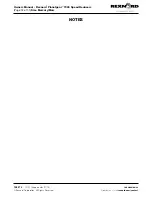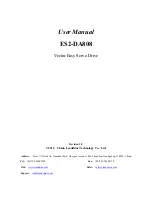
Owners Manual • Rexnord
®
Planetgear
™
7000 Speed Reducers
(Page 28 of 33)
Size Mercury/Mars
158-110
10/21 (Supersedes 01/15)
© Rexnord Corporation. All Rights Reserved.
Contact us — visit
Section IX — Troubleshooting
This troubleshooting guide addresses questions that may be encountered in regards to Planetgear 7000 speed reducers.
EXCESSIVE TEMPERATURE [more than 200°F (93°C)]
POSSIBLE CAUSES:
POSSIBLE SOLUTIONS:
OVERLOAD
• Compare actual reducer load with rated load on the nameplate. If the HP or torque is greater, or the speed is slower than stated on
the nameplate, the reducer is probably overloaded. Contact a Rexnord Planetgear Representative; may require a speed change or a
larger unit.
TIGHT OR DEFECTIVE BEARINGS
• Inspect bearings for excessive wear or discoloration due to heat. If either is present, replace the bearings. Refer to Section 6.0 for
replacing bearings.
EXCESSIVE AMBIENT
TEMPERATURE
• Provide ventilation for the reducer.
• Paint white if reducer is in direct sun light.
• If conditions are extreme, contact a Rexnord Planetgear Representative for assistance.
IMPROPER OIL, OIL LEVEL, OLD,
OR CONTAMINATED OIL
• Make sure lubricant is correct for reducer. A mistake frequently made is to use automotive oil. This is incorrect and will frequently
cause the reducer to overheat.
• Check the oil level in the reducer. Too much as well as too little oil can cause the reducer to overheat.
• Check to see that oil has not lost its lubricating property. If oil viscosity is too low, this will result in high oil temperatures.
PLUGGED SHROUD
• Make sure area immediately in front of fan shroud is clear.
OVERSPEED
• Reduce input speed to reduce oil temperature. If reducer input speed is above the stated value on the nameplate, this would raise oil
temperature due to increase in internal windage.
RESTRICTED VENT PLUG
• Remove and clean vent plug.
• Replace vent plug.
BEARING DAMAGE
IMPROPER ADJUSTMENT
• Adjust bearing to proper axial bearing clearance as instructed in Section 6.0.
LACK OF LUBRICATION, IMPROPER
LUBRICATION, OLD, OR
CONTAMINATED OIL
• Replace damaged bearings as instructed in Section 6.0. Note: Check hub and shaft for potential damage or heat distress.
EXCESSIVE OVERHUNG LOAD
• Reduce overhung load. Move the sprocket or sheave closer to the bearings or increase the diameter of both the driven and the driver
BEARING NOISE
DEFECTIVE BEARING
• Inspect and replace bearings if necessary. Reference Section 6.0.
IMPROPER BEARING ADJUSTMENT
• Adjust bearing endplay. Reference Section 6.0.
WRONG OR INSUFFICIENT
LUBRICATION
• Make sure that enough oil of the correct grade is used. Reference Section 3.0.
LEAKAGE
DAMAGED OR WORN SEALS
• Replace seals. Reference Section 6.0.
BEARINGS OUT OF ADJUSTMENT
• Reset bearings. Reference Section 6.0.
EXCESSIVE TEMPERATURE,
CAUSING BRITTLE SEALS
• Isolate reducer from source of extreme temperature.
• Install high temperature seals.
ABRASIVE OR CORROSIVE
ATMOSPHERE
• Isolate reducer seal area from environment.
• Re-grease frequently.
RESTRICTED VENT PLUG
• Remove and clean vent plug.
• Replace vent plug.
SPLIT-LINE LEAKAGE
• Make sure fasteners are torqued correctly. Reference Table 18.
• Remove suspect hub. Visually inspect mating surfaces for rises or dings. File smooth (do not allow file shavings to enter gearing or
bearings) apply gasket eliminator and replace hub.
DAMAGE OF FASTENERS
FAILURE OF FASTENERS
• Make sure fasteners are torqued correctly. Reference Table 18.
• Make sure the correct grade of fastener is used. All reducer fasteners should be ANSI B18.2.1 Grade 5 or ISO 898/1 Grade 8.8 or
• Check length of fastener.
FASTENER LOOSENING
• Make sure fasteners are torqued correctly. Reference Table 18.
• For highly vibratory environments, loctite fasteners and torque, or use studs and double nut.






































